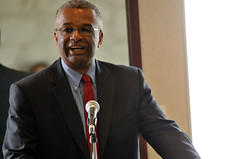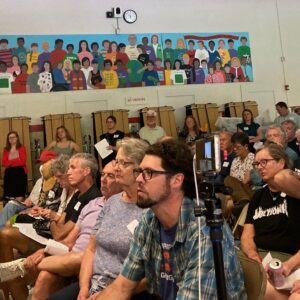An unprecedented partnership between federal agencies was on full display at a press conference this morning on the 23rd floor of the Portland Hilton. The occasion was the announcement of a $2 million federal grant for Washington County through the Obama Administration’s TIGER II program. The grant will go toward a transportation and community planning project for the Aloha-Reedville community (between Hillsboro and Beaverton).
I’ll share more about that project later today, but I want to share a conversation I had prior to the formal portion of the event with the Deputy Secretary of the Department of Housing and Urban Development (HUD), Ron Sims.
“We now know it’s very very costly to support expansion and distance and the smart thing to do is to have people in more intimate, functioning neighborhoods.”
During the brief interview, Sims shared more about how this Washington County grant is a direct outcome of President Obama’s interest in tying our investments in transportation with public health and livable community outcomes (and of course, I also asked him about bicycling’s role in that equation).
Sims is the former King County Executive (based in Seattle). He recalled that when President Obama campaigned through Portland and Seattle in 2008, he was struck by, “How everything seems to be woven together” in terms of transportation and housing (the 70,000 people that showed up to Waterfront Park for his rally — many of them via bus, MAX and bicycle — probably left an impression). After he was elected, during an interview for the HUD job, Obama asked Sims, “How did you do that?”
“You can’t tell a person who is obese that you need exercise if the sidewalks are narrow and there are no walking or bicycle paths.”
When Obama asked Sims what his biggest barrier was to integrating transportation and housing, he said without hesitation, “The federal government.” Sims got the job.
Sims was referring to silos that existed between the DOT, HUD, and the Environmental Protection Agency. With colleagues at those agencies on board and “What started as a really good question from the President,” Sims says the silos no longer exist and the collaboration has “blossomed.” (Specifically, the heads of the DOT, HUD, and the EPA now work together in the Partnership for Sustainable Communities.)
In my brief discussion with Sims, I came away feeling like he really gets it. Below are some excerpts…
On planning and density:
“We always thought you had to integrate the built environment with transportation, the issue is to do it in a sustainable fashion. The cities of the future are the cities that will be smart resource-wise. We’re going to have density, the issue is, how do you move around that density? Do you provide arterials that you’ll have to rebuild and rebuild and rebuild; or do you provide options for people such as public transportation, pedestrian pathways, and bicycle paths?
… We now know it’s very, very costly to support expansion and distance and the smart thing to do is to have people in more intimate, functioning neighborhoods.”
On equity, transportation, and bicycling:
“Another thing we brought into play were equity issues. We can predict lifetime earnings of kids and the health outcomes of our populations by by zip code. We were looking at these disparities and said, ‘How do you break the disparities?’
As this country begins to rebuild its neighborhoods and build new ones, we have to ask, ‘What does a healthy neighborhood look like?’ You can’t tell a person who is obese that you need exercise if the sidewalks are narrow and there are no walking or bicycle paths. So we said, why not start to incentive and encourage people to plan those type of neighborhoods?
In King County for instance, we have a pretty extensive bike network, but none of them in poor neighborhoods. I used to ride with a friend and I’d say, ‘You and I bike a lot, but no one looks like us.’ The reason why is because we do not have bike paths in poor neighborhood. We want people to bike and bike safely. Biking in the street is not safe and biking on sidewalks is a hassle. We have to create what I call ‘bicycling opportunities.’
I bike to work and I’m a believer in bicycling both for health and transport. For us, we believe it is a choice people should be able to make and it should be convenient for them to make it. You can also created dedicated bicycles paths for people who don’t want to be ‘street savvy’. It’s hard enough bicycling without having to worry about the driver on the cell phone who doesn’t see you.”
On bicycling and health:
“We’re seeing early onset of Type II diabetes among kids. Our issue about getting people on bicycles is very important because if the Type II diabetes bulge continues it’s going to collapse our health care system. So the reason we have a strategic interest in bicycling and we’re looking at bicycling as a strategy is to say, we’ve gotta get these kids on bikes to school, to the playground, to the store, to see their friends…
We know that with the bicycle as a method of transportation and exercise we can lower obesity rates in this country. And remember that obesity is occurring in poor neighborhoods, not in affluent neighborhoods… Those kids in affluent neighborhoods tend to have bicycle paths, so one of our social goals is to say, ‘Make those investments dog gone it!'”
It’s one thing to hear about all these issues from non-profit groups and research papers, but to hear this perspective and understanding directly from the horse’s mouth, is very re-assuring.







Thanks for reading.
BikePortland has served this community with independent community journalism since 2005. We rely on subscriptions from readers like you to survive. Your financial support is vital in keeping this valuable resource alive and well.
Please subscribe today to strengthen and expand our work.
I have heard Sims speak before. He is very sharp and he absolutely gets it about bicycling. Great to get a behind-the-scenes glimpse at how the TIGER II grant requirements were developed.
“…Biking in the street is not safe and biking on sidewalks is a hassle. We have to create what I call ‘bicycling opportunities.’ …” Ron Sims/HUD
Describing biking in the street as ‘not safe’, is rather simplistic, but it’s a point that many people can relate to. Even though frequently the best option, I’ll agree that biking on the sidewalk is a hassle.
“…I bike to work and I’m a believer in bicycling both for health and transport. For us, we believe it is a choice people should be able to make and it should be convenient for them to make it. You can also created dedicated bicycles paths for people who don’t want to be ‘street savvy’. It’s hard enough bicycling without having to worry about the driver on the cell phone who doesn’t see you.” …” Ron Sims/HUD
That’s a mouthful of issues raised, but Sims having said that does give a sense that he understands some of the diverse needs of people using bikes for transportation.
Well conditioned, competent cyclists are capable of traveling very briskly…20mph-30mph, even faster on descents. They probably want, and should be welcome to ride almost any street they choose. At the same time, there’s likely a whole, untapped segment of the public that would seriously consider the bike for transportation if they knew that within their general route to work, school, etc., a comfortable, enjoyable and safe 10mph-15mph bike road was available to them.
“…Sims was referring to silos that existed between the DOT, HUD, and the Environmental Protection Agency. …” maus/bikeportland
‘silos’? I’ve never heard the use of that word relative to this subject. As far as I know, silos are something farmers store grain in, and governments store missiles in. Maybe the appropriation of the word in this story has something to do with the latter meaning, as in government agencies warring with each other.
It is so very sad how obesity became a disease of poverty. This is all so preventable, and the solution as low tech as the humble bicycle.
This is a very uplifting and heartwarming article. Thank you Jonathan for the pick-me-up
Finally found a decent definition of “departmental silos”:
from http://www.bptrends.com/resources_glossary.cfm?wordid=1585D3FD-1031-D522-3C41C050AD12C6DA
Silo Thinking
This is a metaphor drawn from the large grain silos that one sees throughout the US Midwest. It is a term of derision that suggests that each department on an organization chart is a silo and that its stands alone, not interacting with any of the other departmental silos.
There is a strong tendency amongst civil servants, from bottom level employees all the way to the top, to think that any problem that is not strictly addressed by the company, department or organizational mission statement is not their problem.
Often you’ll hear “go see someone else, that’s not my problem” or the even more depressing “Yes, I know that would solve my problem but I’m not allowed to do or think about that.”
We saw this some months ago with the barrier put up by ODOT at 82nd at the MAX station. ODOT’s focus is highways and as such they only think with in that framework. Their chief concern is the safe movement of as many automobiles as possible and as such pedestrians are a hazard to the speedy movement of autos.
You can easily imagine that the question they asked the community was something like “would a barrier on 82nd st make your drive better?” when they could have asked a less biased question like “would a barrier to pedestrian crossings at on 82nd st at the MAX platform improve your community?
The answer to the first auto biased question is easy: Yes, removing every other mode of travel from this area makes it quicker for autos.
The answer to the second question is more nuanced: livability has to be defined and all users have to be polled. I’m willing to bet that the bulk of the transit users are not part of the local community that ODOT questioned.
This is essence of “silos” in government: and unwillingness or psychological inability to think outside your direct mission and to consider how secondary effects may make yours and others jobs more difficult.
Silo thinking is not limited to government; it is a common issue for all large organizations.
q`Tzal …thanks for digging up the ‘silo’ definition as it relates to inter-government assumption of responsibility. Your example was also helpful.
I got experience some of this from the inside in my military and I’m sure we’ve all experienced this at a DMV and other gubment agencies we’re loathe to deal with.
<arm chair psychologist hat>
I suspect that there is little avoiding this problem, at least in America.
In my experience, when I attempt to present to people the secondary, tertiary and negative feedback effects of their actions, they start by appearing to care about the problem, gradually gloss over in the eyes and eventually respond with something to the effect of “I’m not in school/college anymore, I don’t want/have to think.”
There seems to be a set of blinders we have adopted in America to other’s suffering. It is easier to imagine that a problem does not exist than it is to have any level of empathy and know that you could do something about it but are not. Once the thinking begins it is easy to realize that one person can make a difference.
/arm chair psychologist hat
Maybe my delivery stinks, but most people don’t seem to want to think.
wsbob- if you need an understanding of a silo’d organization buy any Sony product.
Obesity is a symptom of poverty. A bicycle may treat that symptom, but will not address poverty as a whole.
BDoB #10
“..not treat poverty as a whole.”
No but as community full of underpaid citzens discover they no long need that 2nd auto, or possibly any auto, they then have much more income available to spend.
On average an American household spends from 25%~35% on automobile related costs.
Multiplied by the whole community and the extra spending power should benefit local businesses and lead to higher local median income.
q`Tzal, tell that to a community living without adequate transit service and bike/ped infrastructure.
What is never addressed is the role of the cost of housing in tilting people towards their transportation choices.
The selling and renting price of real property needs to be regulated to end the practice of moving far enough away from one’s job to afford housing. The free market is a crock–a sane set of policies would force the cost of driving up and the cost of housing down, US Constitution be damned.
Sims is good. He’s a NWesterner and definitely gets it. A few comments:
Historically, the wealthy and middle class lived in the cities and the poor lived outside the cities. It’s only the automobile that allowed the suburbs to exist. Portland growth boundary and embrace of a bike-friendly culture has put pressure on the in-close neighborhoods. This gentrification will change the “poor” neighborhoods. Providing bike paths will make those neighborhoods even more attractive and probably accelerate the change. I’m not saying it’s good or bad, just that it’s a factor.